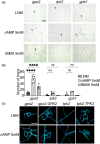The cAMP-PKA pathway regulates prey sensing and trap morphogenesis in the nematode-trapping fungus Arthrobotrys oligospora
- PMID: 35993904
- PMCID: PMC9526039
- DOI: 10.1093/g3journal/jkac217
The cAMP-PKA pathway regulates prey sensing and trap morphogenesis in the nematode-trapping fungus Arthrobotrys oligospora
Abstract
Sensing environmental factors and responding swiftly to them is essential for all living organisms. For instance, predators must act rapidly once prey is sensed. Nematode-trapping fungi (NTF) are predators that use "traps" differentiated from vegetative hyphae to capture, kill, and consume nematodes. These traps undergo drastic and rapid morphological changes upon nematode induction. Multiple signaling hubs have been shown to regulate this remarkable process. Here, we demonstrate that the conserved cAMP-PKA signaling pathway exerts a crucial role in trap morphogenesis of the nematode-trapping fungi Arthrobotrys oligospora. A gene deletion mutant of the PKA catalytic subunit TPK2 proved insensitive toward nematode presence. Moreover, we show that the G protein alpha subunit GPA2 acts upstream of adenylate cyclase, with GPA2 deletion resulting in substantially reduced trap formation, whereas exogenous provision of cAMP rescued the prey-sensing and trap morphogenesis defects of a gpa2 mutant. Thus, we show that cAMP production triggered by G protein signaling and downstream PKA activity are vital for prey-sensing and trap development in A. oligospora, demonstrating that this highly conserved signaling pathway is critical for nematode-trapping fungi and nematode predator-prey interactions.
Keywords: Arthrobotrys oligospora; PKA; cAMP signaling pathway; nematode-trapping fungi; predator–prey interaction.
© The Author(s) 2022. Published by Oxford University Press on behalf of Genetics Society of America.
Conflict of interest statement
None declared.
Figures




Similar articles
-
Prey sensing and response in a nematode-trapping fungus is governed by the MAPK pheromone response pathway.Genetics. 2021 Feb 9;217(2):iyaa008. doi: 10.1093/genetics/iyaa008. Genetics. 2021. PMID: 33724405 Free PMC article.
-
Natural diversity in the predatory behavior facilitates the establishment of a robust model strain for nematode-trapping fungi.Proc Natl Acad Sci U S A. 2020 Mar 24;117(12):6762-6770. doi: 10.1073/pnas.1919726117. Epub 2020 Mar 11. Proc Natl Acad Sci U S A. 2020. PMID: 32161129 Free PMC article.
-
Laboratory Maintenance and Culturing of the Nematode-Trapping Fungus Arthrobotrys oligospora.Curr Protoc. 2021 Feb;1(2):e41. doi: 10.1002/cpz1.41. Curr Protoc. 2021. PMID: 33544447
-
Predator-prey interactions of nematode-trapping fungi and nematodes: both sides of the coin.Appl Microbiol Biotechnol. 2018 May;102(9):3939-3949. doi: 10.1007/s00253-018-8897-5. Epub 2018 Mar 9. Appl Microbiol Biotechnol. 2018. PMID: 29523933 Review.
-
Recent Advances in Life History Transition with Nematode-Trapping Fungus Arthrobotrys oligospora and Its Application in Sustainable Agriculture.Pathogens. 2023 Feb 22;12(3):367. doi: 10.3390/pathogens12030367. Pathogens. 2023. PMID: 36986289 Free PMC article. Review.
Cited by
-
GprC of the nematode-trapping fungus Arthrobotrys flagrans activates mitochondria and reprograms fungal cells for nematode hunting.Nat Microbiol. 2024 Jul;9(7):1752-1763. doi: 10.1038/s41564-024-01731-9. Epub 2024 Jun 14. Nat Microbiol. 2024. PMID: 38877225 Free PMC article.
-
The nematode-trapping fungus Arthrobotrys oligospora detects prey pheromones via G protein-coupled receptors.Nat Microbiol. 2024 Jul;9(7):1738-1751. doi: 10.1038/s41564-024-01679-w. Epub 2024 Apr 22. Nat Microbiol. 2024. PMID: 38649409 Free PMC article.
-
Characterizing the Role of AosfgA and AofluG in Mycelial and Conidial Development in Arthrobotrys oligospora and Their Role in Secondary Metabolism.Microorganisms. 2024 Mar 19;12(3):615. doi: 10.3390/microorganisms12030615. Microorganisms. 2024. PMID: 38543666 Free PMC article.
-
Predation by nematode-trapping fungus triggers mechanosensory-dependent quiescence in Caenorhabditis elegans.iScience. 2025 May 30;28(7):112792. doi: 10.1016/j.isci.2025.112792. eCollection 2025 Jul 18. iScience. 2025. PMID: 40585354 Free PMC article.
-
AoChk1 Is Required for Sporulation, Trap Formation, and Metabolic Process in Arthrobotrys oligospora.J Fungi (Basel). 2025 Aug 19;11(8):602. doi: 10.3390/jof11080602. J Fungi (Basel). 2025. PMID: 40863555 Free PMC article.
References
-
- Bahn Y-S, Xue C, Idnurm A, Rutherford JC, Heitman J, Cardenas ME. Sensing the environment: lessons from fungi. Nat Rev Microbiol. 2007;5(1):57–69. - PubMed
-
- Bai N, Zhang G, Wang W, Feng H, Yang X, Zheng Y, Yang L, Xie M, Zhang K-Q, Yang J, et al. Ric8 acts as a regulator of G‐protein signalling required for nematode‐trapping lifecycle of Arthrobotrys oligospora. Environ Microbiol. 2022;24(4):1714–1730. - PubMed
-
- Borges-Walmsley MI, Walmsley AR. cAMP signalling in pathogenic fungi: control of dimorphic switching and pathogenicity. Trends Microbiol. 2000;8(3):133–141. - PubMed
-
- Brefort T, Doehlemann G, Mendoza-Mendoza A, Reissmann S, Djamei A, Kahmann R. Ustilago maydis as a pathogen. Annu Rev Phytopathol. 2009;47:423–445. - PubMed
Publication types
MeSH terms
Substances
Supplementary concepts
LinkOut - more resources
Full Text Sources
